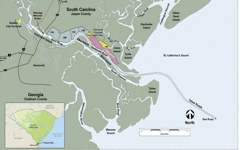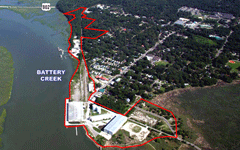Two crucial Lowcountry development projects face complex challenge. By Lolita Huckaby
Rice planters, truck farmers, shrimpers, the military, tourists – the Lowcountry economy has been tied to them all at one time or another. But once again, the area’s future is focused on the water where two major developments could mean significant change and millions of dollars.
For the past decade, development of a maritime shipping port on the South Carolina side of the Savannah River and the redevelopment of the Port of Port Royal have been on the minds of local leaders.
And Sen. Tom Davis, R-Beaufort, has been right in the middle of both of those developments, as a former member of the S.C. Ports Authority, then as Chief of Staff for Gov. Mark Sanford and since January 2009, one of Beaufort County’s two state senators.
“Both of these projects are incredibly important to the future of our area… and incredibly complex,” Davis said in a pre-Christmas interview. “As anyone knows who’s been watching these developments for any time, it’s not just a matter of selling the property in Port Royal or building a multi-million dollar facility on the Savannah River. There’s a lot more to it.”
JASPER OCEAN TERMINAL

Officials in this tip of the Palmetto State have been talking about a major shipping facility on the lower reaches of the Savannah River since the first Swiss settlers paddled up the creek and settled in Purrysburg, now little more than a crossroads in Jasper County.
While the shipping facility on the Georgia side of the river, owned by the Georgia Port Authority, grew and flourished into one of the largest shipping facilities on the East Coast, the late Henry Moss, who served as Jasper County Administrator for 14 years and before that Beaufort City Manager, led the campaign for a comparable development on the South Carolina side of the river.
One of his biggest opponents to the project came from within, the S.C. State Ports Authority whose directors weren’t interested in seeing a facility that would compete with the state’s largest port in Charleston.
Local supporters had their eyes on a 1,500-acre tract of barren, riverfront land on the east side of US 17, at the foot of the Talmadge Bridge. The property belonged to the Georgia Department of Transportation, which has used the former wetlands for years to dump spoil dirt dredged from the bottom of the river.
Moss died in 2008 without seeing the first shovel of dirt dug for the project, but he did live long enough to see the governors of South Carolina and Georgia stand on the site in March 2007 and pledge their cooperation to see the project through. The deal was even sealed with an impromptu exchange of neckties.
Somewhat ironically, the port campaign today is being lead by another Moss, Dean Moss (no relation to Henry) who serves as executive director of the Beaufort-Jasper Water and Sewer Authority and who chairs the Savannah River Maritime Commission.
It is the commission’s assignment to closely monitor the U.S. Army Corps of Engineers’ plans to dredge 26 miles of the Savananh River channel from 42 to 48 feet to accommodate the super freighters moving through the renovated Panama Canal.
Just the past fall, a former U.S. Coast Guard captain, doing analysis on the project as a consultant, recommended the Corps reconsider their calculations, taking into account the huge freight ships now require 50-feet of depth for operation.
The deeper drafts would also require the proposed dredging project to go out into the Atlantic as much as 20 miles, significantly more than the four to five miles initially proposed.
The proposed dredging project, which is needed for maintenance of the Savannah ports, also poses certain environmental challenges, with the 29,000-acre Savannah Wildlife Refuge across the river and the underground aquifer, supplier of drinking water for much of the Lowcountry, running underneath.
The S.C. Coastal Conservation League is also closely watching the dredging project while supporting development of the Jasper terminal as the most viable and less environmentally threatening.
While the bureaucracy of the dredging project is debated, the Terminal Office Project Office, a bi-state committee chaired by attorney and former SPA member Bill Bethea of Bluffton, works on a interstate compact between South Carolina and Georgia which will outline how the future facility will be owned and operated.
While supporters of the Jasper Ocean Terminal had hoped the facility would be up and running by 2014, consultants have more recently said a 2024 date might be more realistic.
“In the meantime, we’ll continue to work with all sides – the folks in Charleston and Columbia who want to make sure the Charleston facilities are protected and the folks across the river in Savannah, who want the same thing for their facilities,” said Davis. “I understand there’s a natural tendency to protect what you have.
“But my goal… the big challenge here…is to get both sides to work together for a common goal. This can be a win-win, but if we don’t work together the business can go further north to Norfolk or south to Jacksonville. Then we’d both lose out,” he added.
PORT OF PORT ROYAL

It’s time and the State Ports Authority that have frustrated Port Royal leaders who have been waiting for the sale of some primo real estate, 300 acres along a one-mile stretch of Battery Creek. When Pier 21 was closed in 2004 by the SPA after 50 years of operation as a commercial shipping dock, Gov. Sanford ordered the SPA to sell the property.
At the time, then-SPA President and CEO Bernard Groseclose warned the process wouldn’t be like “flipping a switch” and the people of Port Royal have been waiting ever since.
While town residents worked on a long-range vision plan for the property converting the former storage area for kaolin, or clay exports into a waterfront walkway, retail and residential spaces and several parks, the SPA has attempted to market the property.
An initial formal proposal fell through in 2007 when David Staley of the Hilton Head Main Street Realty and his partners, Global Asset Alternatives of Atlanta withdrew their offer, blaming a softening economy.
There was criticism leveled at Gov. Sanford for his involvement, which some saw as a further delay, when it came to light he had discussed the company’s proposal with SPA officials.
There was even more talk about Sanford’s involvement in the sales negotiations when it became public that Jim Chaffin, one of the developers of Callawassie and Spring Islands and considered a possible buyer for the Port Royal property, had been a Sanford campaign contributor.
The property whose master plan includes a 140-room hotel, a 225-slip marina and 340 residential units was initially listed at $27 million with NAI Avant, a Charleston commercial real estate marketing firm handling the sale for the SPA. Recent reports list the property at a reduced price of $20.4 million.
According to Davis, negotiations with a Charleston-based development firm are progressing and expected to be announced by the Dec. 31 deadline for a sales agreement although details of the contract will still probably have to be worked out.
“We established a deadline for the sale because we want this to be resolved. Otherwise, the land would transfer from the SPA to the state Budget and Control Board for further action,” Davis said.
Davis likes to use a coastal analogy when he talks about the Jasper County port project. He compares the efforts to move the project forward to a boiling pot of crabs, where an attempt by one to escape is thwarted by the others, who pull the loner back in.
He might want to consider switching from crabs to oysters, which rest in the mud and, after being provoked and irritated long enough, produce a single, valuable pearl.
Two websites for additional information:







